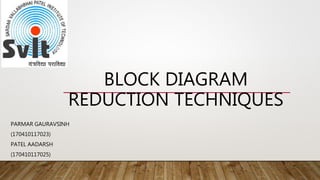
Block Diagram Reduction
- 1. BLOCK DIAGRAM REDUCTION TECHNIQUES PARMAR GAURAVSINH (170410117023) PATEL AADARSH (170410117025)
- 2. BLOCK DIAGRAM REDUCTION • A complex control system consists of several blocks. Each of them has its own transfer function. But overall transfer function of the system is the ratio of transfer function of final output to transfer function of initial input of the system. This overall transfer function of the system can be obtained by simplifying the control system by combining this individual blocks, one by one. The technique of combining of these blocks is referred to as block diagram reduction technique. For successful implementation of this technique, some rules for block diagram reduction to be followed.
- 3. BASIC CLOSED LOOP TRANSFER FUNCTION • Consider a simple closed loop system, • R(s) = Laplace of input signal • C(s) = Laplace of output signal • E(s) = Laplace of error signal • B(s) = Laplace of feedback signal • G(s) = forward transfer function • H(s) = feedback transfer function
- 4. for open loop transfer function, as no feedback present, transfer function can be given by: Open loop transfer function = G(s).H(s)
- 5. BLOCK DIAGRAM REDUCTION RULES • Rule 1: Blocks In Series Any finite specific number of blocks arranged in series can be combined together by multiplication as shown below: The above blocks shown can be combined together and replaced with single block as Output C(s) = G1 x G2 x R(s)
- 6. RULE 2: BLOCKS IN PARALLEL • When the blocks are connected in parallel combination, they get added algebraically (considering the sign of the signal) • The above blocks can be replaced with single block as • C(s) = R(s)G1 + R(s)G2 – R(s)G3 C(s) = R(s) (G1 + G2 – G3)
- 7. RULE 3: ELIMINATION OF FEEDBACK LOOP • We can use Closed loop transfer function to eliminate the feedback loop present.
- 8. RULE 4: ASSOCIATIVE LAW FOR SUMMING POINT • This can be better explained by taking below diagram Y= R(s) – B1 C(s) = y – B2 = R(s) – B1 – B2 This law is applicable only to summing points which are connected directly to each other.
- 9. RULE 5: SHIFTING OF A SUMMING POINT BEFORE A BLOCK • When we shift summing point before a block, we need to do transformation in order to achieve the same result. Please refer the diagram C(s) = GR(s) + X After shifting the summing point, we will get C(s) = [R +(X/G) ] G = GR + X which is same as output in the first case. • Hence to shift a summing point before a block, we need o add another block of transfer function ‘1/G’ before the summing point as shown in figure.
- 10. RULE 6: SHIFTING OF THE SUMMING POINT AFTER A BLOCK • When we generally shift summing point after any block, we required to do the transformation to attain the same (required) result. Please refer the below diagram . • C(s) = (R + X)G After shifting the summing point, we will get • C(s) = (R +X) G = GR + XG which is same as output in the first case. • Hence to shift a summing point before a block, we need to add another block having same transfer function at the summing point as shown in fig
- 11. RULE 7: SHIFTING OF TAKE-OFF POINT AFTER A BLOCK • Here we want to shift the take – off point after a block, as shown in diagram • Here we have X = R and C = RG (initially) • In order to achieve this we need to add a block of transfer function ‘1/G’ in series with signal taking off from that point.
- 12. RULE 8 : SHIFTING OF TAKE-OFF POINT BEFORE A BLOCK • Here we want to shift the take – off point before a block, as shown in diagram • Here we have X = R and C = RG (initially) • In order to achieve this we need to add a block of transfer function ‘G’ in series with X signal taking off from that point.
- 13. RULE 9 : SHIFTING A TAKE-OFF POINT AFTER A SUMMING POINT • can be transformed to (refer both the diagrams) • Before shifting take-off point, initially we have: • C(s)=R±Y • and Z = R ± Y (initially) • Hence if we want to shift a take off point after a summing point, one more summing point needs to be added in series with take-off point.
- 14. RULE 10: SHIFTING A TAKE-OFF POINT BEFORE A SUMMING POINT • Suppose if we want to shift take off point before a summing point, then initially we have • C(s)=R±Y • and Z = R ± Y (initially) • this can be transformed to (refer both the diagrams) • In order to satisfy this condition, we need to add a summing point in series with the take-off point.
- 15. EXAMPLE:-